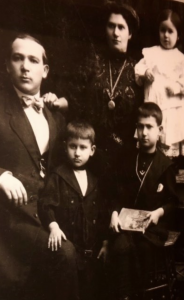COVID and Me and the Flu of 1918

Janet Langsam’s family before the flu epidemic of 1918
The flu epidemic of 1918 was not a story that was taught in every classroom in America. But for me, it was personal. I was named Janet Frances after my father’s mother Frances, my grandmother whom I never met because she died tragically in the flu epidemic of 1918, long before I was born. Perhaps that is why I know almost nothing about her other than what, for me, was the scary part. Families like mine tend to hide their trauma in unspoken silences, which only later seem to leak out incidentally and without context. So it was that, as a ten-year-old, l learned that Grandma Fanny as she was called, was not the only family member who died in 1918. I learned at the time that my father had a sister, Clara, whom he never talked about, only to say that she was closest in age to him in the family pecking order. Clara also died next to her mother during that tragic epidemic
in 1918. She was only ten. Until COVID-19, I hadn’t thought much about Clara for many years. For me, Clara was a symbol of my own fragility, which was not something to dwell on. However, the recent dialogue about whether COVID was deadly for children brought it all back, including the annual visits to Clara’s tiny headstone next to her mother’s at Mt. Judah Cemetery. I wondered anew whether my older brother Charles was named for Clara. I will never know. I wondered anew whether there had been time to mourn a mother and child during a pandemic. So swift was the loss. So quickly were the remaining three children shuttled off to their mother’s relatives in Pittsburgh. Perhaps the end of life was a less harsh reality than how to go on, how to manage survival for a family altered forever by a disease not of their making. This, no doubt, will be one of the 200,000 stories that will be told about the current COVID crisis.


Connect with Janet